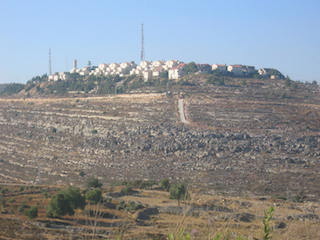UPDATES
Settlement housing starts, by the numbers
March 6, 2014 | Ahron Shapiro

During an interview published on Sunday between Bloomberg‘s Jeffrey Goldberg and US President Barack Obama, the President made the allegation that “we have seen more aggressive [Israeli West Bank] settlement construction over the last couple years than we’ve seen in a very long time”.
Then on Tuesday, the Australian news portal Yahoo7 published an AFP story headlined “West Bank settlement starts double in 2013: Israel”. The wire story, apparently distributed without a byline, used newly released data from the Israeli Bureau of Statistics as the basis for a story that relied on comments from Obama, Palestinian official Jibril Rajub and Peace Now to promote a narrative that the construction is out of proportion to previous trends and imperils the possibility of creating a contiguous Palestinian state as part of a two-state peace outcome. (SBS published a similarly themed story from the AAP on their website.)
Internationally, the story received considerable attention, while in Israel, a Ha’aretz editorial worked off some of the same talking points (subscription required).
Beyond the rhetoric, however, the real questions that must be asked are whether current construction in the settlements are actually at high levels, and does the character of construction taking place adversely affect the possibility of a viable Israeli-Palestinian peace agreement? In response to both questions, the evidence overwhelmingly says “no”.
Evelyn Gordon, writing at Commentary Magazine‘s website, said that although it’s true that the number of housing starts doubled last year, it was starting from a very low point, and Obama ignored the fact that overall, Netanyahu has built far fewer homes in the settlements than his predecessors.
As a simple glance at the annual data published by Israel’s Central Bureau of Statistics reveals, there has been less settlement construction during Benjamin Netanyahu’s five years as Israeli premier (2009-13) than under any of his recent predecessors.
During those five years, housing starts in the settlements averaged 1,443 a year (all data is from the charts here, here and here plus this news report). That’s less than the 1,702 a year they averaged under Ehud Olmert in 2006-08, who is nevertheless internationally acclaimed as a peacemaker (having made the Palestinians an offer so generous that then-Secretary of State Condoleezza Rice couldn’t believe she was hearing it). It’s also less than the 1,652 per year they averaged under Ariel Sharon in 2001-05, who is similarly lauded internationally as a peacemaker (for having left Gaza); the fact that even Sharon out-built Netanyahu is particularly remarkable, because his term coincided with the second intifada, when demand for housing in the settlements plummeted. And it’s far less than under Ehud Barak, who is also internationally acclaimed as a peacemaker (for his generous offer at Camp David in 2000): One single year under Barak, 2000, produced more housing starts in the settlements (4,683) than the entire first four years of Netanyahu’s term (4,679).
The Jerusalem Post noted that settler leaders were in some ways disappointed by the figures since they actually revealed much fewer housing starts than had been seen in any region in Israel proper – despite the fact that the major settlement blocs are suburbs of major Israeli cities like Jerusalem and Tel Aviv.
The Council of Jewish Communities in Judea and Samaria said that it embraced the report, but noted that the figures were deceptive in that it made it seem as though more building occurred outside the pre-1967 lines than within them. According to the CBS, the 2,534 housing starts in the settlements make up only a fraction, 5.7%, of the 44,343 such units through the country.
The council’s deputy head, Yigal Delmoni, said that in reality there were fewer housing starts in West Bank settlements than in any other region in Israel.
“We call on the government to immediately publish all the tenders for Judea and Samaria that it has frozen,” he said.
Doing so would provide affordable housing close to both the country’s center and Jerusalem, he said.
Meanwhile, Ha’aretz (subscription required) – a paper editorially opposed to settlements – conceded that most of the housing units were apartment buildings – a construction type found almost solely in the largest settlements, ones that all peace proposals between Israel and the Palestinians have assumed will become part of Israel as part of a perspective land swap arrangement. One must add to this observation that a substantial number of new homes in settlement blocs are of the single family unit variety as well.
Of the 2013 housing starts, 1,710 were in apartment buildings typical of the larger settlements, like Maale Adumim, Beitar Ilit and Modiin Ilit, while 824 were single units in the smaller settlements.
Ha’aretz also noted that settler leaders had complained that current construction levels do not meet the “natural growth” requirements of settler communities – a standard which the Netanyahu government has openly supported – to allow grown settler children to purchase homes near their parents or growing families to purchase bigger apartments and homes within their settlements.
Moreover, said council Deputy Director General Yigal Dilmoni, the quantity is still insufficient to meet the needs of the settlements’ population, which is growing “at two and a half times the rate” of the rest of the country.
And of course, contrary to the implications of both Obama and the wire services, no new settlements are being built, not are the boundaries of existing settlements expanding under policies in place since 2004. This means that the implication that the growth in the settlements are making a two-state resolution impossible are absurd. They are not taking any new land so there is no reason they should make Palestinian statehood any harder to achieve.
Clearly, by any historical or contextual standard, housing construction within Israel’s West Bank settlements under the Netanyahu government remains at some of the lowest levels in years and is far from the insurmountable “obstacle to peace” that media reports have suggested.
Ahron Shapiro
Tags: Israel





